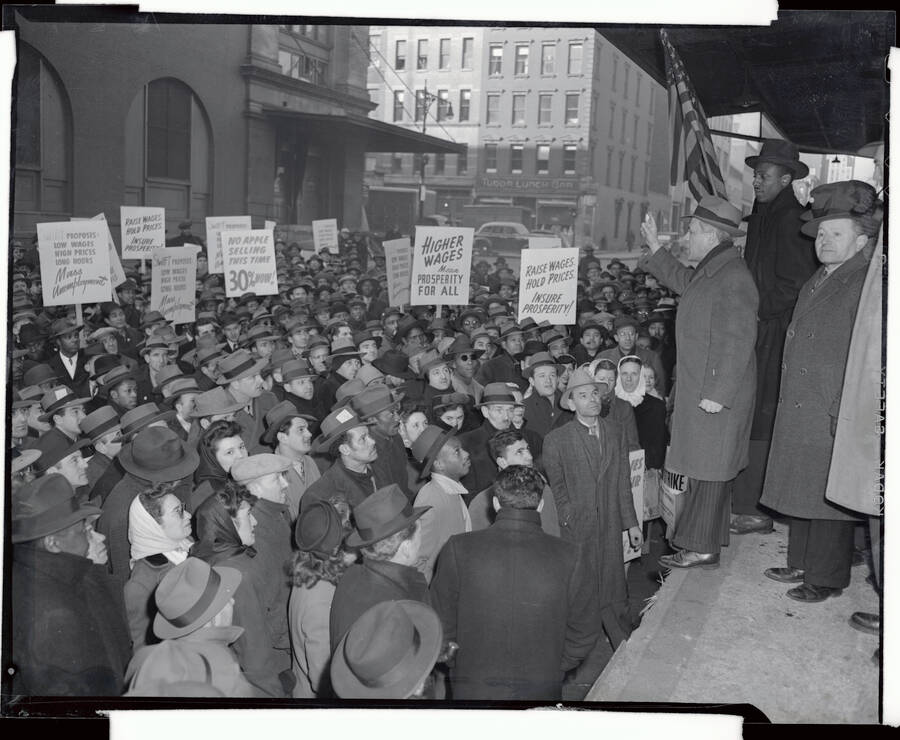|
MICHAEL BEYEA REAGAN IN THESE TIMES The following is an excerpt from the book Intersectional Class Struggle (2021, AK Press). In the 1930s, a new type of union, an “industrial” union that welcomed all workers in a single workplace emerged as the cutting edge of working-class struggle. Previously, unions and employers both had a long history of racism and support for white supremacy. Certain jobs were reserved for whites, and Black workers were kept out of factories and union halls. This had catastrophic consequences for the working class. For example, in the 1919Steel Strike, employers brought in 30,000 Black and immigrant workers to break the strike staged by white workers and their racially exclusive unions. Long prevented from joining those unions, and the labor movement in general, Black workers crossed the picket lines. With that, employers got production moving again, defeated the strike, and prevented worker organizing for the next 15 years. In the 1930s, as the labor movement thought about how to win during the Great Depression, the lessons of the 1919 Steel Strike loomed large; workers’ movements would have to be anti-racist and intersectional if they were to win. The strength of the model of industrial unionism was that it required overcoming racial divides within the workplace. New organizations, such as the Congress of Industrial Organizations (CIO), ran anti-racist trainings to facilitate Black and white workers organizing together to fight employers. It formed interracial social groups and sport teams, challenged public displays of racism, and highlighted the treatment Black workers faced on the job. This was largely the influence of the communist and other leftist organizers in the union, for whom anti-racism had long been part of their practice of labor organizing. But at its core were the ideas that Black and white workers have a common enemy in capitalists and capital, and that efforts to divide workers by race weaken working-class power. With these union campaigns, along explicitly anti-racist lines, unionization at places such as General Motors in Flint or in the mills of U.S. Steel finally became possible.
In the estimation of the historian and civil rights activist W.E.B. Du Bois, the CIO was one of the most successful anti-racist efforts in U.S. history. “Probably the greatest and most effective effort toward interracial understating among the working masses,” he writes, “has come about through the trade union.” He believed that shared class interests were a mechanism to overcome ingrained racial hostility. Because of the CIO, workers “in the steel and automotive industries have been thrown together, Black and white, as fellow workers striving for the same objects. There has been on this account an astonishing spread of interracial tolerance and understanding.” Those victories breaking down white supremacy were won through intersectional class struggle; in Du Bois’s words, “Probably no movement in the last thirty years has been so successful in softening race prejudice among the masses.” Black workers were harmed the most by racism and white supremacy, but white workers were harmed too as their unions were broken and their living standards eroded by taking the side of employers in supporting white supremacy against working-class solidarity. In short, all workers have a collective interest to overcome white supremacy and labor-market competition together. In practice, this often means prioritizing the Black freedom struggle or movements for civil rights to build that solidarity. Read the rest here: https://inthesetimes.com/article/cio-anti-racism-civil-rights-industrial-unions-workers-organizing-black-lives-matter
0 Comments
Your comment will be posted after it is approved.
Leave a Reply. |
Principles North Star caucus members
antiracismdsa (blog of Duane Campbell) Hatuey's Ashes (blog of José G. Pérez) Authory and Substack of Max Sawicky Left Periodicals Democratic Left Socialist Forum Washington Socialist Jacobin In These Times Dissent Current Affairs Portside Convergence The Nation The American Prospect Jewish Currents Mother Jones The Intercept New Politics Monthly Review n+1 +972 The Baffler Counterpunch Black Agenda Report Dollars and Sense Comrades Organizing Upgrade Justice Democrats Working Families Party Poor People's Campaign Committees of Correspondence for Democracy and Socialism Progressive Democrats of America Our Revolution Democracy for America MoveOn Black Lives Matter Movement for Black Lives The Women's March Jewish Voice for Peace J Street National Abortion Rights Action League ACT UP National Organization for Women Sunrise People's Action National Network for Immigrant and Refugee Rights Dream Defenders |

 RSS Feed
RSS Feed